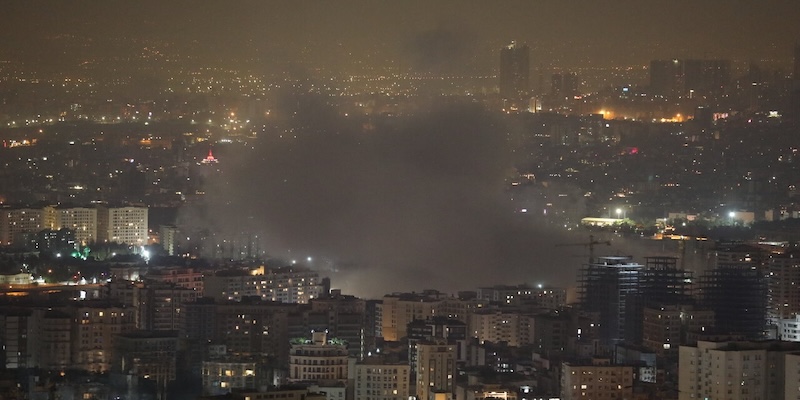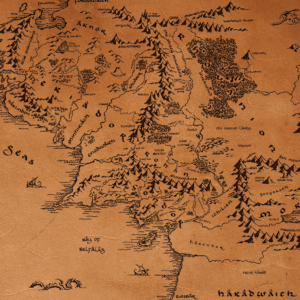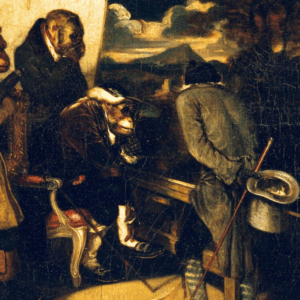
A Record of Vanishings: Neda Maghbouleh on the Stress Response of Seeing Iran Bombed
Remembrances in the Midst of Deportations, ICE Seizures, and Israel's Attack on Tehran
1
I finally learn how to record my phone screen to save my aunt’s Instagram story before it vanishes.
The video opens on her silver Swatch, a date and time stamp: 28 Khordad (June 17, 2025), 12:10 pm Iran Standard Time. She pulls the camera away from her body and spins in place, slowly, filming the streets around her. “No buses or taxis!” she hollers in Persian off camera, wonderfully belligerent, like she’s been dared to stay put.
It’s five days after Israel started bombing her city. Nine hours after Trump warned “Everyone should immediately evacuate Tehran!”
Instead, my aunt takes a walk and records it.
She paces through the hushed streets of Northern Tehran, calling out khalvat! Every time a lone car passes: khalvat! At the sight of a man in a red t-shirt, walking down the center of what’s usually six clogged lanes of traffic: khalvat! No other pedestrians, just him and my aunt shouting into the quiet.
In everyday Persian, khalvat means empty or uncrowded.
In everyday Persian, khalvat means empty or uncrowded. It can mean private and hidden. In Sufi and Shi’i traditions, it’s also a word for retreat; withdrawal from the world, solitude for reflection. In her voice, khalvat is a joke, a dare, and a fact.
The video cuts to a cavernous café and bakery with high ceilings and huge windows in a neighborhood called Tajrish. It’s kinda khalvat. There are nine customers and workers, nearly all men. She zooms in on her donut—chocolate glaze with what looks like crushed pistachios. Is this the Dubai chocolate trend that’s everywhere on Instagram?
On the table beside her donut is the baseball cap she’s taken off. Then her camera tilts up to short silver hair, uncovered. She grins into the camera, confident, unfazed by the gaze.
It’s not a protest, exactly. Instead, it’s a sly objection to displacement, a refusal to hide or disappear.
On Instagram, my aunt is back outside. She flips the camera again. This time, to a bombed-out pharmacy that looks like a box of my daughter’s LEGOs: windows blown out, smoke-scorched concrete.
She pans across the street to what’s left of a six-story marble building. The upper floors collapsed or scorched, hollowed out by fire. But on the ground floor, two storefronts remain: one, a rug store with an elegant sign still intact; the other, blasted open and burned.
The video ends with my aunt making it back home. She marks the two hours that passed with a final close-up on her silver Swatch: Khordad 28 (June 17) at 2:20 pm Iran Standard Time. The whole recording is one minute, six seconds, and I save it to three different cloud-based storage services.
I text the video to my longest-running group chat. One friend says she recognizes the ruined storefront as a branch of her bank in Iran. At least I think that’s what she said. Our messages auto- delete after 24 hours.
Our group chat is the best record of my life I’ve never kept. I’ve known the four other Iranian American women in it since our twenties, and I’m forty-three now. We started the group chat exactly ten years ago. It’s a vanishing archive of our mental health; we write to each other in disappearing ink. Not just for privacy, but for what we think is protection.
We’ve each been flagged, or doxxed, or accused of sympathizing with an enemy. We’ve been pulled aside at airports, questioned in partitioned rooms, told to report to government offices with our documents in hand. Because of this, we let our encrypted messages disappear. Khalvat.
*
2
In 1966, a woman chained herself to the Golden Gate Bridge. Her name was Yvonne d’Angers, born Mahviz Daneshforouz in Tehran in 1944.
She immigrated as a teenager to the United States and was in San Francisco by 1962. There, she became the headlining act at the Off Broadway Club at the corner of Broadway at Kearny in North Beach, owned by her second husband, a sports and entertainment entrepreneur.
Reputed to the be the second-ever topless performer in North Beach, she was photographed by Playboy magazine, shared the club’s stage with Lenny Bruce, and was dubbed “The Persian Lamb” by the press. By the grand opening of Caesars Palace in Las Vegas, she was the original Cleopatra. That same year, in 1966, she was ordered deported.
Instead, Yvonne stayed and recorded it.
She chained herself to the Golden Gate Bridge wearing a Barbie-pink catsuit. In one photo, she’s cuffed at the wrists and ankles. A heavy chain drapes across her chest like a necklace. Behind her, the bay glints. In front of her, microphones and cameras swarm her face. She’s smiling.
This wasn’t the first time Yvonne d’Angers battled the authorities. After arriving on a student visa as a teenager, she was one of four people arrested on charges of obscenity and lewd conduct in a widely publicized raid of North Beach clubs. It was meant to be a test case for San Francisco’s crackdown on the city’s changing culture, an example to be made. Yvonne and the others were all acquitted in court a few weeks later.
But not long after, Yvonne was ordered to show herself at the Immigration and Naturalization Service on Sansome Street. It was called INS at the time and ICE today, still in that building. The official charge was immigration fraud: a short-lived marriage in 1961 to an American man deemed a sham for U.S. citizenship. The timing of the deportation order, right after her obscenity acquittal, made the message clear. She had crossed too many lines. Iranian. Immigrant. Female. Sexual. Visible.
What the photos can’t show exactly is how casually she tossed the keys into the Bay, over her right shoulder. Now you can watch it on TikTok, or on Instagram Reels. Black-and-white news footage from KRON 4 has been digitized and chopped into clips. You can hear her voice.
“I only want to stay in this country,” she tells a man in a sheriff’s uniform. He asks whether she plans to be clothed during the protest. “Which would you prefer?” she replies, grinning.
She lost her first appeal against deportation in 1966. More deportation orders followed in 1967 and 1970. Her requests to stay were denied by subsequent courts, including the Board of Immigration Appeals in Washington DC. But Yvonne didn’t leave.
Instead, she was photographed in her dressing room by Diane Arbus.
It’s performance, protest, hustle. Influencer shit. She understood the camera and how to use it. Yvonne d’Angers was never deported, and she died in 2009, memorialized online by those who loved her most as an accomplished painter, model, and college graduate.
3
I drive down from Canada into the U.S. to see my parents. I drive through the Peace Arch crossing. Over a thousand Iranians—mostly civilians—are dead in the U.S.–Israel war against Iran.
In our group chat, someone says when Israel bombed Evin Prison, the notorious political prison in Tehran, at least a hundred trans prisoners were buried alive underground.
They had been caged in the basement.
My friend said they died mazloum, a word that means wronged, oppressed, but also carries the weight of moral injury. In Shi’a tradition, to die mazloum is to be martyred without justice or witness, your story left in fragments for others to try and piece together.
I get a work email from CAUT, Canada’s association for university teachers, warning us to avoid non-essential travel to the U.S. A State Department cable from June 2025 orders U.S. visa applicants to make their social media accounts public. People keep talking about “cleaning” their phones. I think about my phone like it’s a public billboard.
I hold both a U.S. and Iranian passport. They are my insurance policy and my greatest liability. I never carry them at the same time if I can help it.
The Iranian one gets me into Iran. The American one gets me into and out of nearly everywhere else. These two citizenships pretend the other doesn’t exist, until you’re a dual national used as a bargaining chip in geopolitical warfare, or just crossing a border during a war you didn’t start.
I also have a Canadian passport I picked up along the way, like extra insurance. But even that’s starting to change. The Prime Minister of Canada said Trump is “trying to break us so the U.S. can own us.” Canadian friends have canceled their work trips, their vacations in the U.S. this summer. Anything they couldn’t cancel or resell, like baseball tickets, they decided to just take the loss on.
Before we drive to her grandparents’ house, I’m explaining to my eleven-year-old daughter what visas are, and how some passports give you power while others get you searched. I can’t tell if the expression on her face, open and grave, is because she’s genuinely interested in passport and visa regimes or if this is the social response I have parented her to give.
When we get to my parents’ house, they tell us an Iranian man they know from the next town over was picked up by ICE on his way to the gym. His asylum application was denied twenty years ago, and now the U.S. says he ignored a final order of removal.
His lawyer says he had a check-in scheduled with ICE in two weeks. But he was grabbed out of his car and swept out of state to a regional ICE Processing Center before his lawyer could reach him. I don’t know what scares me more—that it happened, or that my parents barely blinked.
*
4
Trump posts on Truth Social: “ISRAEL is not going to attack Iran. All planes will turn around and head home, while doing a friendly ‘Plane Wave’ to Iran. Nobody will be hurt, the Ceasefire is in effect! Thank you for your attention to this matter!” Israel reportedly killed 100 more Iranians and injured another thousand after Trump’s post.
That day, Instagram shows me an ad for a product called Stress Response Clinical Strength Invisible Antiperspirant Deodorant.
Does Instagram know about my stress response because it knows I’m Iranian? Because my family didn’t evacuate Tehran? Because my aunt hasn’t posted an Instagram Story in days, and I don’t know if that means something, or if she’s just turned off her phone? Because I keep watching videos I shouldn’t—like the CCTV clip from Tehran crashing my feed, showing the exact moment Israel’s bombs blew the pharmacy in my aunt’s disappearing Instagram story into a smoking pile of LEGOs?
Does it know I cross a border, again and again and again? Instagram knows everything about me, and nothing at all.
Does Instagram know about my stress response because it knows I’m Iranian?
I am not being forced to leave any country, nor am I chaining myself to any bridge. My bank branch is still standing, and I have my possessions, food, and aid.
I’ve already agreed to the Terms and Conditions, and I let agents, artificial and otherwise, read the texts I haven’t already vanished on my own. The sweat is pooling in my armpits, and Instagram is on in the background, and my phone is a public billboard. It’s sitting in my lap doing a friendly plane wave from the border while I scroll through our group chat. I’m trying to remember what we said to each other before it disappears.
Khalvat.
______________________________
Neda Maghbouleh
Neda Maghbouleh is a writer and scholar based in Vancouver, British Columbia. Her book The Limits of Whiteness explores race, belonging, and misrecognition among Iranian Americans, and was a finalist for a PROSE Award from the Association of American Publishers. She is an associate professor of sociology at the University of British Columbia, where she holds the Canada Research Chair in Race, Ethnicity, Migration and Identity. She will be in residence at Hedgebrook in 2025, working on her next book of narrative nonfiction.












